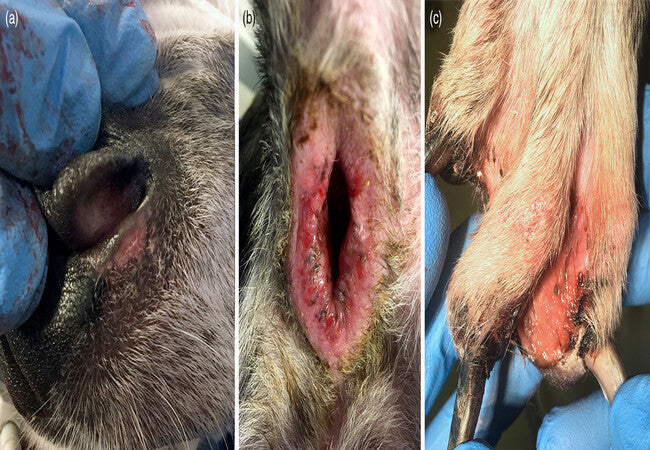Vet’s 2025 Guide to Canine Cutaneous Lupus Erythematosus (DLE) 🩺 Recognize, Treat & Support

In this article
Vet’s 2025 Guide to Canine Cutaneous Lupus Erythematosus (DLE) 🩺 Recognize, Treat & Support
By Dr. Duncan Houston BVSc
💡 What Is Cutaneous Lupus Erythematosus?
Cutaneous lupus erythematosus (CLE) in dogs is an autoimmune skin disorder characterized by interface dermatitis—immune-mediated damage at the base of the epidermis. The most common form is discoid lupus erythematosus (DLE), which primarily affects the nasal planum, muzzle, lips, and face.
🚩 Who’s at Risk?
- 🐾 Common breeds: German Shepherds, Siberian Huskies, Collies, Shelties, Viszlas, GSHPs.
- ☀️ UV light exposure—especially in light-colored or sparsely furred noses—is a key trigger.
- 🧬 Genetic predisposition indicated by familial cases; at-risk dogs may act from juvenile to mid-adult age (~0.5–7 yrs).
👀 Clinical Signs to Watch For
- ❄️ Depigmentation of the nasal planum—smooth, grey or pink instead of cobblestone black.
- 🧊 Scaling, crusting, erosions, ulcers on nose, lips, eyes, pinnae, footpads.
- 🟥 Erythema and scar tissue development over time.
- ⚖️ Lesions may remain localized or spread; intensely itchy cases are rare.
🧪 Diagnostic Steps
- Physical & history: pigment loss, UV exposure, breed.
- Rule out differentials: nasal solar dermatitis, pemphigus, infections.
- Skin biopsy: interface dermatitis with basal cell apoptosis confirms the diagnosis.
- Optional tests: ANA for systemic lupus; chest/renal evaluation if systemic signs present.
🛠 Treatment Strategy
1. Sun Avoidance & Protection 🌞
- 🧢 Avoid peak sun hours; use shade cloth or UV-rated dog jackets.
- 🧴 Apply veterinarian-approved sunblock to nose and exposed skin.
2. Topical Therapies
- 📝 Potent corticosteroid creams to reduce local inflammation.
- 🟦 Topical tacrolimus (0.1%)—effective and steroid-sparing.
3. Systemic Treatments
- 💊 Oral corticosteroids (prednisone) for moderate/severe cases.
- 💉 Immunosuppressants: azathioprine, chlorambucil, ciclosporin, mycophenolate.
- 🔹 Tetracycline + niacinamide alternative to immunosuppressives.
- 🔬 Oclacitinib (JAK inhibitor) shows rapid lesion remission in CCLE variants.
📈 Monitoring & Prognosis
- 📆 Recheck every 4–8 weeks until control achieved; then every 6–12 months.
- 📉 Good prognosis if localized; UV avoidance often keeps remission ongoing.
- 🔁 Generalized CLE variants may require lifelong therapy; relapses common if sun-exposed.
- ⚠️ Rare transformation to systemic lupus; monitor ANA status, CBC, kidney/liver labs.
- 🧑⚕️ Potential for squamous cell carcinoma exists—sun avoidance critical.
🏠 Ask A Vet App: Home‑Support Tools 📲
- 📆 UV exposure reminders and medication schedule alerts.
- 📸 Photo log for remote lesion tracking and vet review.
- 📊 Record pigment changes, crusting, new lesions.
- 🔔 Alerts for worsening that prompt in-clinic review.
- 📚 Guides on sunblock, topical application, and biopsy aftercare.
🔑 Key Takeaways 🧠✅
- 🌟 Cutaneous lupus (DLE) is an autoimmune skin disease primarily affecting the nose and face.
- 🛡 Sun avoidance, biopsy diagnosis, topical and systemic immunosuppression are central to care.
- 📊 Prognosis is good when managed with UV protection and owner vigilance.
- ⚕️ Rare progression to systemic lupus; monitoring and awareness are essential.
- 📱 Ask A Vet app enhances home monitoring, care coordination, and early intervention.
🩺 Final Thoughts ❤️
In 2025, canine cutaneous lupus erythematosus is well-understood and treatable with a combination of sun management, topical and systemic therapies, and regular veterinary review. When paired with owner diligence and digital monitoring support from the Ask A Vet app, dogs with DLE can enjoy long remission periods and maintain a high quality of life—even when facing a chronic autoimmune condition. 🐾✨
Visit AskAVet.com and download the Ask A Vet app to schedule UV alerts, log treatments, upload lesion photographs, and stay connected with your veterinary team anytime. 📲🐶






